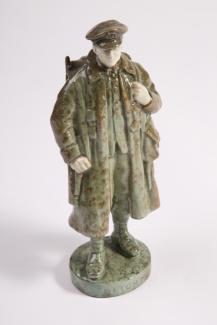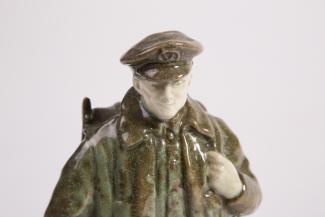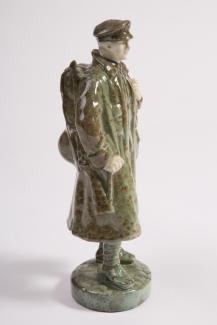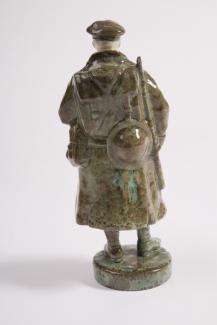Ernest William Light modelled this figure, titling it ‘Blighty’ on the base, in 1918. It is by far his best work for the Doulton company, or for Wedgwood, who reproduced some of his bird and animal models at about the same time. He later became master in charge of Stoke School of Art - some would say predictably given the rather academic nature of his work in general. However, this time the artist touched on real, immediate themes of anxiety and loss that defied the academic approach, and he seems to have been uniquely inspired.
‘Blighty’ has an odd ring to our ears. It originated in the days of the Raj – Hindustani for ‘foreign’; it was applied to things brought by the British from home, and by extension to the mother country itself. If used now it’s for comic effect, aping the character of some retired, and probably gout-stricken colonel. But in 1918, even when Florrie Forde sang Take Me Home to Dear Old Blighty, it was without irony. Instead it expressed a sincere patriotism that seems to exist far less, or is less often admitted to, today.
The figure is identified as an infantryman in the South Staffordshire Regiment by his cap badge and other kit, all of which Light rendered with respectful accuracy. By 1918, like other First World War forces, the South Staffs had suffered huge numbers of casualties. At the battle of Loos alone, in 1915, they lost 448 men. Among the wounded were 130 incapacitated by chlorine gas, in use for the first time by their own side, which failed to carry into enemy lines on an unpredictable wind. All in all it’s hard to imagine more of a contrast with Doulton’s normal output of ‘crinoline ladies’.
Although the war effectively ended at 11am on 11th November 1918, at the time when Light started work on this figure there would have been no imminent prospect of troops returning. Nor has the soldier received ‘a Blighty one’, a wound just serious enough to send him back to the UK. So presumably the title simply reflects a longing for home and a clue to the direction of his gaze.








